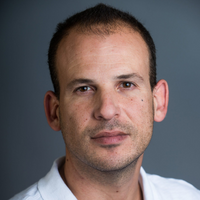Prof. Niv Papo (pictured below) and his colleagues were striving to understand how structurally similar protein-protein interactions (PPIs) could exhibit huge differences in binding affinity despite similar structural characteristics.

Their findings were just published in the prestigious Journal of The American Chemical Society (JACS).
To achieve this goal, Prof. Niv Papo and his colleagues studied three homologous protease–inhibitor PPIs that span 9 orders of magnitude in binding affinity.
For these three PPIs, they constructed quantitative binding landscapes reporting binding affinity changes for tens of thousands of single and double inhibitor mutants, thus generating an unprecedented amount of mutational data that could be used as benchmarks for testing their new computational methodology and for the design of new high-affinity protease inhibitors.
To generate this extensive data, they took advantage of the powerful methodology based on yeast surface display and next-generation sequencing recently developed by their group (Heyne et al, 2020, Nature Comm.). Using the obtained data, they demonstrated striking differences between the binding landscapes of the three PPIs that could be explained by the level of the PPI evolutionary optimality.
Furthermore, they studied additivity and cooperativity for tens of thousands of mutations in these PPIs and demonstrated that the coupling energy between two mutations depends not only on the positions of mutations but also on the identities of the interacting partner and the mutated amino acid.
This is the first time such a study has been performed on such a large scale, allowing the researchers to reveal a number of interesting insights into the evolution of protein-protein interactions and to explain them from structural and energetic perspectives. In addition, the evolutionary trends observed here are likely to be universal to other biological complexes in the cell, the researchers wrote.
Prof. Papo is a member of the Avram and Stella Goldstein-Goren Department of Biotechnology Engineering and the National Institute for Biotechnology in the Negev.
Additional researchers included Michael Heyne, Jason Shirian, Itay Cohen, Yoav Peleg, Evette S. Radisky, and Julia M. Shifman of Hebrew University.
The research was supported by the Israel Science Foundation (ISF) (grant nos. 1873/15, 2335/20, 1615/19), by the European Research Council (ERC) (grant 336041), by the US-Israel Binational Science Foundation (BSF), the Israel Cancer Research Foundation, and the U.S. National Institutes of Health (grants R01 CA154387 and R01 977 GM132100).